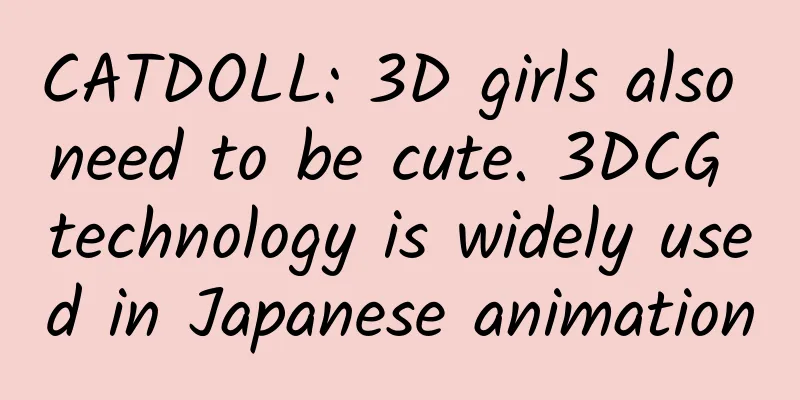CATDOLL: 3D girls also need to be cute. 3DCG technology is widely used in Japanese animation

|
Audiences familiar with American animations will certainly be familiar with 3D animations. Disney's "Frozen", which has been very popular recently, is a good example. Looking at the Asian market, Japan has indeed produced a variety of 3D animation masterpieces in recent years, so the production techniques of 3D cels have also attracted attention. The so-called 3D cel is a 3DCG technique that allows 3D animations to have the expressiveness of 2D traditional hand-painted works. The number of full CG animations produced with 3D cels, such as "Arpeggio of Blue Steel", "Knights of Sidonia", and "Ronia, Daughter of the Green Forest", has increased sharply in the past one or two years. Originally, comic fans had such ideas about 3D animations as "3DCG animations and hand-painted animations are completely different things" and "3DCG girls are not cute at all", but now their cognition has been subverted by the birth of 3D cel production techniques. Is it difficult to turn beautiful girl characters into 3DCG? Simply put, hand-drawn animation is a collection of countless cartoons, while 3DCG animation completes a series of processes such as character modeling, styling, and shooting on the computer. 3DCG animation can rotate the character model while changing the camera angle to produce a smoother character movement effect. Since the release of the all-CG theatrical animation "Toy Story" in 1995, Disney and Pixar have continued to produce all-CG animations. In the Japanese domestic animation industry around 2000, "3DCG of mechanical characters such as robots, hand-drawn human characters, and a combination of CG and hand-drawn" accounted for half of the works. The reason why Japanese animation uses hand-drawing when creating human characters is that it is too difficult to express their unique shapes with 3DCG. For example, if the traditional image of a beautiful girl with a pointed face and large eyes in Japanese animation is 3DCGed, the character will become very unnatural. In addition, 3DCG characters tend to be "too smooth" in their movements, which will also cause a sense of disobedience for fans who are accustomed to the rhythm of traditional hand-drawn animation (24 frames per second). Therefore, 3D cels were born by fine-tuning the shapes and movements of 3DCG characters and integrating the hand-drawn rendering style. Follow the hand-drawn animation production method The TV animation "Arpeggio of Blue Steel" aired from October to December 2013 brought 3D cels to the forefront. This was a rare all-CG production for late-night animation at the time. The natural movements of the beautiful girls created with hand-painted renderings were refreshing to fans, who exclaimed "so cute!" According to FlyingDog producer Nan Jian, when the project was discussed within the company, the view that "beautiful girls made with 3DCG are definitely not cute" emerged. "Therefore, although 3DCG animation does have problems with the smoothness of the movements, during the production of this work, we fine-tuned the movements of the characters that appear in the impactful scenes." "Arpeggio of Blue Steel" not only has 3DCG dynamic performances, but also incorporates the natural movements of traditional hand-drawn animations, following the hand-drawn animation production method. The result not only won the recognition of anime fans, but also proved that the image of a beautiful girl in 3DCG can also become very cute. Can 3DCG reduce the cost of animation production? 3DCG animation will incur costs when modeling characters, but because the characters stored in the computer can be used as materials and reused repeatedly, the cost can be reduced. Hand-drawn animation will incur huge labor costs because of a large number of manual drawing processes, but 3DCG does not need to draw the character movements one by one, so the number of employees can be controlled. Mr. Nan said that taking the work "Arpeggio of Blue Steel" as an example, although a large amount of money was invested in character modeling in the early stage of production, because only a "small but elite" staff was hired, the final cost was almost the same as that of ordinary late-night animation. Is "Sazae-san" suitable for 3D cel production techniques?! Based on the experience gained from making Arpeggio of Blue Steel, Producer Minami said, "If you consider the cost, not all animations are suitable for 3DCG." Because 3DCG has initial costs when modeling characters, it is "more suitable for animations with fewer characters, costumes, and backgrounds." "The original characters can be used all the time, and new characters are not added very often... Considering this point, Uptown Tomoo (produced by 3DCG and broadcast on NHK General Channel) meets the requirements. Works like Sazae-san and Crayon Shin-chan should also be suitable." In addition to the aforementioned Arpeggio of Blue Steel, full CG animations such as Knights of Sidonia and Paradise Exiled have been successful, and anime fans are gradually getting used to 3DCG. The second movie version of Arpeggio of Blue Steel, Cadenza, will be released in October this year, and the development momentum is very good. Therefore, we can foresee that there will be more and more excellent full CG animations in the future. On the other hand, if a long-running work like Sazae-san is really made into a CG, there will definitely be many people who find it difficult to accept. Whether the new 3DCG animation can penetrate into groups other than anime fans may be a new issue. |
<<: CATDOLL: Hestia dominates the Comic1 doujinshi market with her big breasts
>>: CATDOLL: The makeup photos of Kaneki Ken from the stage play "Tokyo Ghoul" are revealed
Recommend
CATDOLL: The new CM of the animated theatrical version of "Classmates" is released and will be released in February 2016
The animated theatrical version of the popular BL...
CATDOLL: "One Piece" new movie Luffy as Kintaro mysterious new character debut
The new movie version of One Piece, One Piece Fil...
CATDOLL: "Akihabara Trip" TV animation to be aired in January 2017
The TV animation of "Akihabara Trip" ha...
CATDOLL: "Pure Maria" OP preview MV ZAQ sings "Philosophy of Dear World"
The animation "Pure Maria" which will b...
CATDOLL: Uchida Maaya's "I Want to Be a Twintail" OP Single Cover Released
The new October anime "I Want to Be a Twinta...
CATDOLL: The release date of the "Sword Art Online" movie is set to be February 18 next year
The release date of the Sword Art Online theatric...
CATDOLL: Anime "Monster Hunter Stories" announces additional voice actors including Ayaka Asai
The new anime "Monster Hunter Stories" ...
CATDOLL: Celebrate the 45th anniversary of the broadcast of "Sazae-san" and hold the National Sazae-san Exhibition
"Sazae-san" has been serialized in the ...
CATDOLL: "Fox Spirit Matchmaker" cover competition ended successfully, super popular singing took the lead
The "Fox Spirit Matchmaker" cover compe...
CATDOLL: The first trailer of "Digimon Adventure tri." will be released on May 6
On the official website of Digimon, the newly hat...
CATDOLL: "Spirited Away" is a ratings powerhouse, and its popularity remains high after seven rounds of broadcast
Not long ago, we saw the news in major media: &qu...
CATDOLL: It is rumored that the popular Japanese voice actor Hiroshi Kamiya is married to the cartoonist Hikaru Nakamura
Today, a Japanese website posted a picture saying...
CATDOLL: The latest information on "Food Wars! Soma" will be released on April 3
The food battle anime "Food Wars! Shokugeki ...
CATDOLL: The lead vocal band of "Rainbow Days" will appear in the animation as themselves
The three-member music group "Sonar Pocket&q...
CATDOLL: Japanese junior high school students draw promotional images for swimming pools based on the image from "Free!"
The animation "Free!" is closely relate...









